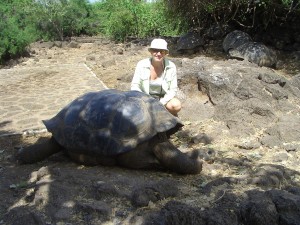Sad news reached the Worldwide Holidays office earlier this week when it was reported that Lonesome George, a Pinta Island tortoise from the Galapagos has died. Lonesome George was the last tortoise of his kind residing in a special conservation area in the Galapagos and has been described as the rarest creature in the world. Lonesome George was over 100 years old when he died on June 24th, it is believed his death may have been related to heart failure.
The Ecuadorean government had been trying to find a suitable female mate for Lonesome George for many years but was unfortunately un-successful and the death of Lonesome George means the world loses his kind as a sub-species.
Galapagos is such an incredible place so much amazing variety of wildlife many of the creatures are endangered species protected by the Darwin Research Station.
Our Galapagos ground agents were kindly able to provide a detailed history of Lonesome George, we hope you find this an interesting read.
Celebrating the Life of Lonesome George
When the Galápagos Islands became a National Park in 1959, conservation priorities were a top priority for the world’s scientific community. Giant tortoises, who gave their names to the remote archipelago, ranked high, together with the need to eradicate introduced animals (rats, goats, etc.) from the archipelago’s days as a pirate bolt-hole.
Hundreds of thousands of giant tortoises had been killed for food during the intense whaling years of the 18th and 19th centuries. Conservation reached Galápagos too late for some. Floreana and Santa Fe Island Giant Tortoises had disappeared long ago, and the only known living tortoise from Fernandina Island was killed and preserved in the name of research and conservation during a United States expedition in 1907. The La Pinta Tortoise was, officially, another species wiped out, while the island itself was plagued by introduced goats, the tortoises’ direct, warm-blooded competitors for food.
Inadvertently, in December 1971 a young snail expert, Joseph Vagvolgyi, while squatting over the resident Bulimulus spp snails of La Pinta Island, was startled by moving shrubbery. He expected goats to have caused the commotion, but instead saw a male tortoise emerging from the foliage. His report went unnoticed until 1972, when a team of park wardens went to La Pinta Island to hunt introduced goats. On that visit an Ecuadorian field biologist, Manuel Cruz, took the opportunity to analyze the stomach content of goats to understand better the effect of goats foraging upon the fragile flora of the Galápagos. Cruz once again stumbled upon the last living tortoise of La Pinta. But this time he opted for rounding up wardens to help him lug the weighty (200-pound/90-kg), reptile down to the beach. A few days later the tortoise was happily ensconced at the Darwin Research Station on Santa Cruz Island.
The relevance of this ‘animal rescue’ didn’t become evident until much later. In the 1970s, each island’s tortoise population was taxonomically seen as a subspecies – with only subtle differences among them. In subsequent years, scientists agreed that they were all different species. The only remaining living tortoise of La Pinta became a “living extinct species”, unless a female was found. From that day forth, the search began to find another female La Pinta tortoise. Officially, a monetary reward still exists for the person who delivers a female La Pinta tortoise to the National Park authorities.
In the meantime, one of the wardens from the 1972 team on la Pinta, Fausto Llerena, took over the care of the all resident tortoises at the Charles Darwin Research Station. George, as he called him, became better known over the years as “Lonesome George”, possibly named after the American comedian George Gobel (1919-1991) who used this nickname in some of his shows.
As the last living tortoise of La Pinta species, Lonesome George soon became a living icon for conservation not only in the Galápagos but also internationally. His image is the logo of the Galápagos National Park and the Charles Darwin Research Station, and he is possibly the world’s most famous reptile. He even has an entry as the rarest animal in the world in the Guinness Book of Records and a clothing line named after him. As author Henry Nicholls puts it: “His story echoes the challenges of conservation worldwide; it is a story of Darwin, sexual dysfunction, adventure on the high seas, cloning, DNA fingerprinting and eco-tourism.”
His departure is felt worldwide. A faint flame of hope remains, following a recent study in northern Isabela (where species with Floreana Island DNA were found), with the tortoises presumably removed in whaling days that carry George’s species DNA. Perhaps George’s death is not entirely the last page of a chapter initially stained by human greed, later redeemed with dedicated efforts towards the preservation of endangered species. As for the old male from La Pinta, he will be remembered for generations to come, and his story will serve to shed light on our responsibility towards the other species on our planet.


